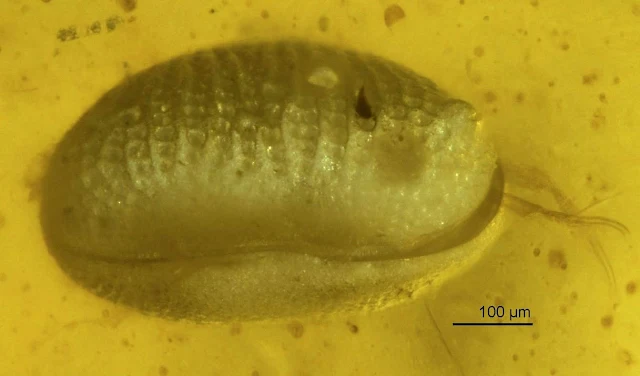World's Oldest Sperm From 100 Million Years Ago Found Fossilised in Amber
 |
| An ostracod trapped in the amber (Image: PA) |
Scientists have discovered what they believe to be the oldest fossilised animal sperm from around 100 million years ago.
An international collaboration between researchers at Queen Mary University of
London and the Chinese Academy of Science in Nanjing has led to the discovery
of world's oldest animal sperm inside a tiny crustacean trapped in amber
around 100 million years ago in Myanmar.
The research team, led by
Dr He Wang of the Chinese Academy of Science in Nanjing, found the sperm in a
new species of crustacean they named Myanmarcypris hui. They predict that the
animals had sex just before their entrapment in the piece of amber (tree
resin), which formed in the Cretaceous period.
Fossilised sperm are
exceptionally rare; previously the oldest known examples were only 17 million
years old. Myanmarcypris hui is an ostracod, a kind of crustacean that has
existed for 500 million years and lives in all kinds of aquatic environments
from deep oceans to lakes and rivers. Their fossil shells are common and
abundant but finding specimens preserved in ancient amber with their
appendages and internal organs intact provides a rare and exciting opportunity
to learn more about their evolution.
Professor Dave Horne,
Professor of Micropalaeontology at Queen Mary University of London said:
"Analyses of fossil ostracod shells are hugely informative about past
environments and climates, as well as shedding light on evolutionary puzzles,
but exceptional occurrences of fossilised soft parts like this result in
remarkable advances in our understanding."
During the Cretaceous period in what is now Myanmar, the ostracods were probably living in a coastal lagoon fringed by trees where they became trapped in a blob of tree resin. The Kachin amber of Myanmar has previously yielded outstanding finds including frogs, snakes and a feathered dinosaur tail. Bo Wang, also of the Chinese Academy of Science in Nanjing added: "Hundreds of new species have been described in the past five years, and many of them have made evolutionary biologists re-consider long-standing hypotheses on how certain lineages developed and how ecological relationships evolved."
The study, published in Royal Society Proceedings B, also has implications for understanding the evolutionary history of an unusual mode of sexual reproduction involving "giant sperm."
The new ostracod finds may be extremely small but in one sense they are giants. Males of most animals (including humans) typically produce tens of millions of really small sperm in very large quantities, but there are exceptions. Some tiny fruit flies (insects) and ostracods (crustaceans) are famous for investing in quality rather than quantity: relatively small numbers of "giant" sperm that are many times longer than the animal itself, a by-product of evolutionary competition for reproductive success. The new discovery is not only by far the oldest example of fossil sperm ever found but also shows that these ostracods had already evolved giant sperm, and specially-adapted organs to transfer them from male to female, 100 million years ago.
Each ostracod is less than a millimetre long. Using X-ray microscopy the team made computer-aided 3-D reconstructions of the ostracods embedded in the amber, revealing incredible detail. "The results were amazing -- not only did we find their tiny appendages to be preserved inside their shells, we could also see their reproductive organs," added He Wang. "But when we identified the sperm inside the female, and knowing the age of the amber, it was one of those special Eureka-moments in a researcher's life."
Wang's team found adult males and females but it was a female specimen that contained the sperm, indicating that it must have had sex shortly before becoming trapped in the amber. The reconstructions also revealed the distinctive muscular sperm pumps and penises (two of each) that male ostracods use to inseminate the females, who store them in bag-like receptacles until eggs are ready to be fertilised.
Such extensive adaptation raises the question of whether reproduction with giant sperms can be an evolutionarily-stable character. "To show that using giant sperms in reproduction is not an extinction-doomed extravagance of evolution, but a serious long-term advantage for the survival of a species, we need to know when they first appeared" says co-author Dr Renate Matzke-Karasz of Ludwig-Maximilians-University in Munich.
This new evidence of the persistence of reproduction with giant sperm for a hundred million years shows it to be a highly successful reproductive strategy that evolved only once in this group -- quite impressive for a trait that demands such a substantial investment from both males and females, especially when you consider that many ostracods can reproduce asexually, without needing males at all. "Sexual reproduction with giant sperm must be very advantageous" says Matzke-Karasz.
The above story is based on Materials provided by Queen Mary University of London.








